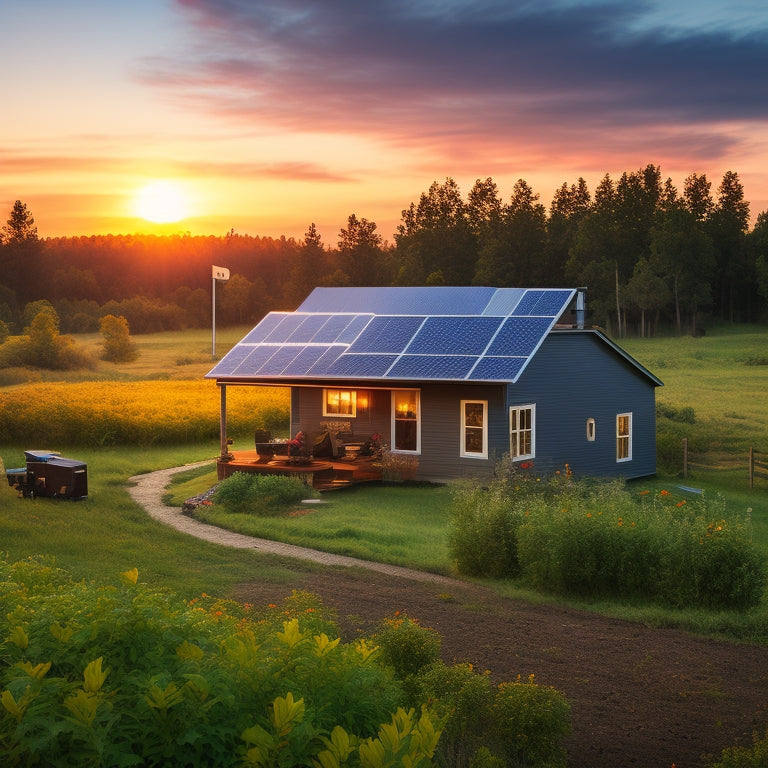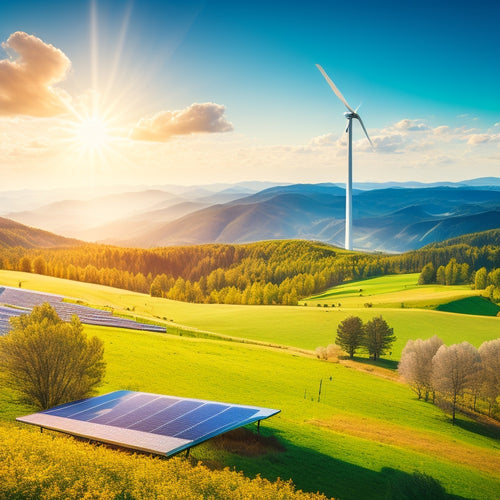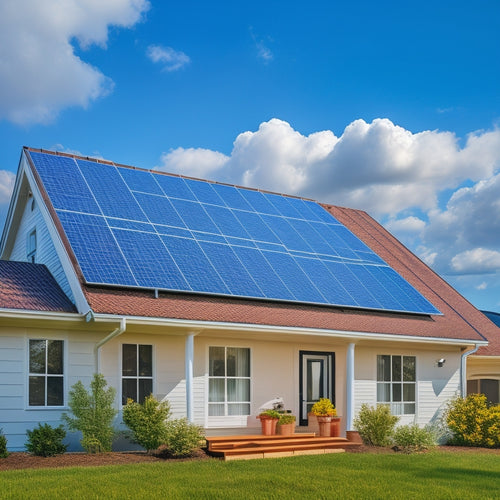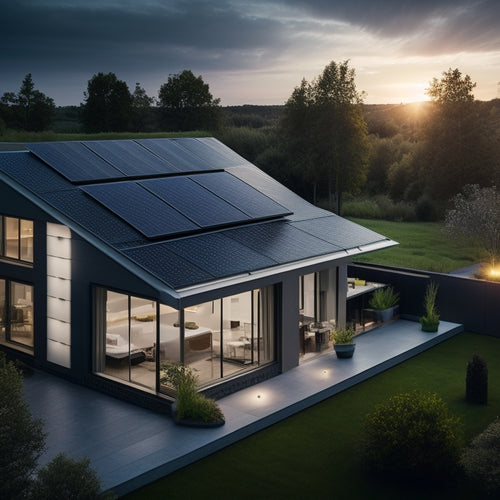
Why Store Energy for Home Independence?
Share
You're seeking energy independence to break free from the grid's uncertainties and reveal a more sustainable, self-sufficient lifestyle. By storing energy, you'll reduce your reliance on fluctuating energy prices and grid outages, ensuring a consistent power supply during emergencies. Investing in energy storage also mitigates price volatility and reduces your carbon footprint. Furthermore, off-grid systems provide reliable backup power, preparing your household for natural disasters and grid failures. As you examine energy independence, you'll find out how customized solutions enable you to control energy usage and make informed decisions, ultimately leading you down a path to enhanced autonomy and a more resilient energy future.
Overview
- Energy storage enables households to be self-sufficient, reducing reliance on the grid and mitigating risks associated with power outages and rate hikes.
- Storing excess energy generated from renewable sources like solar and wind allows for its use during nighttime or on cloudy days, promoting independence.
- Energy storage systems provide backup power during emergencies, ensuring safety and comfort when the grid fails, and reducing dependence on traditional energy providers.
- By storing energy, homeowners can optimize their energy usage, reduce energy waste, and minimize their carbon footprint, contributing to a sustainable living setup.
- Energy storage gives homeowners control over their energy expenses, allowing them to make informed decisions about their energy usage and reduce their reliance on external sources.
Energy Independence for the Future
As the world shifts towards renewable energy sources, your ability to store energy efficiently becomes vital for achieving energy independence in the future.
To secure a sustainable tomorrow, you must adopt innovative technologies that minimize environmental impact. Reliable systems like SimpliPhi Power and Schneider Electric combine performance, durability, and flexibility, designed for energy independence.
Future trends suggest a rise in community initiatives promoting renewable resources, which will drive policy implications and financial incentives for energy storage solutions. Smart grids will play an essential role in energy security, and you'll need to stay ahead of the curve.
By investing in energy storage, you'll not only reduce your carbon footprint but also protect yourself from price volatility and power outages.
Embracing sustainable solutions now will assure a secure energy future.
Cutting Ties With the Grid
You're taking a significant step towards energy independence by cutting ties with the grid. This decision allows you to break free from reliance on traditional energy providers and investigate grid alternatives.
Off-grid solutions, such as solar panels and wind turbines, can generate electricity on-site, reducing your dependence on external power sources. By adopting reliable power supply and incorporating energy storage solutions, you can guarantee a consistent supply of power, even when the grid is down.
Furthermore, off-grid solar systems have minimal environmental impact with no emissions or pollution, contributing to a cleaner, more sustainable future by lowering carbon footprints.
With the right off-grid solutions, you can enjoy the freedom and autonomy that comes with generating and managing your own energy.
Reliability in Emergency Situations
One essential aspect of off-grid energy systems is their reliability in emergency situations. You need a system that can provide backup power when the grid goes down.
With a stored energy system, you're prepared for emergency situations like natural disasters or grid failures. This means you'll have power when you need it most, ensuring your family's safety and comfort.
By storing energy generated from your off-grid system, you're taking a vital step in emergency preparedness, and achieving energy independence which is key to reducing reliance on fossil fuels.
This backup power gives you the independence you desire, allowing you to weather any storm without relying on the grid.
With a reliable stored energy system, you can rest easy knowing you're prepared for whatever life throws your way.
Maximizing Solar Power Potential
When designing your solar power system, you'll want to capture as many peak sun hours as possible to maximize energy generation.
This means strategically positioning your solar panels to receive direct sunlight during the most intense periods of the day.
Peak Sun Hour Capture
Most solar panels produce their maximum power output during peak sun hours, typically occurring between 9 am and 3 pm when the sun is highest in the sky.
To maximize your solar power potential, you'll want to make certain your system is optimized to capture energy during these hours. You can do this by positioning your solar panels at an angle that allows them to receive direct sunlight, and cleaning them regularly to maintain high solar panel efficiency.
Furthermore, investing in advanced battery technology enables you to store excess energy generated during peak sun hours, allowing you to use it when you need it most.
Energy Storage Optimization
Several key factors contribute to energy storage optimization, which is critical to maximizing your solar power potential.
You'll want to take into account your energy usage patterns, the type of battery technology you're using, and the overall energy efficiency of your system.
For example, if you have a high energy demand during peak hours, you'll want to guarantee your energy storage system can meet that demand.
By optimizing your energy storage, you can minimize energy waste, reduce your reliance on the grid, and increase your energy independence.
Advanced battery technology, such as lithium-ion batteries, can provide high energy efficiency and long lifetimes, making them an ideal choice for energy storage optimization.
Reducing Energy Bills Dramatically
By utilizing renewable energy sources and implementing energy-efficient systems, you can slash your energy bills dramatically.
This reduction in energy costs is largely due to the increased energy efficiency of your home. When you generate your own renewable energy, you're no longer reliant on the grid, which means you're not subject to fluctuating energy prices.
Additionally, energy-efficient systems reduce the amount of energy your home consumes, further decreasing your energy bills.
With energy storage, you can store excess energy generated during the day for use at night, reducing your reliance on the grid even further.
This results in significant cost savings, giving you more control over your energy expenses and moving you closer to home independence.
Gaining Control Over Energy Needs
As you endeavor for energy independence, you're likely motivated by a desire for self-reliance and reduced grid dependence.
By gaining control over your energy needs, you'll be able to make informed decisions about your energy usage and optimize your system for maximum efficiency.
Energy Self-Reliance Matters
When you rely on the grid for your energy needs, you're at the mercy of external factors like power outages, rate hikes, and infrastructure failures.
This lack of control can be frustrating and costly. By storing energy for home independence, you take the first step towards energy self-reliance.
You'll no longer be held hostage by utility companies or vulnerable to grid outages. Instead, you'll have the freedom to generate and manage your own energy, ensuring a consistent and reliable supply.
This is the essence of energy sustainability and self-sufficient living. With stored energy, you'll be better equipped to weather any storm, literally and figuratively, and enjoy the peace of mind that comes with being in control of your energy needs.
Reduce Grid Dependence Now
Taking control of your energy needs begins with understanding your current consumption patterns, which is essential for reducing grid dependence.
You need to identify the appliances and devices that consume the most energy in your home. This will help you determine the best off-grid solutions for your specific situation.
By analyzing your energy usage, you can develop a customized energy management plan that suits your needs. This plan should prioritize energy efficiency, optimize energy storage, and integrate renewable energy sources.
With a clear understanding of your energy needs and a well-designed energy management plan, you can greatly reduce your reliance on the grid and take the first step towards achieving energy independence.
Power Your Freedom
Freedom from the grid begins with a significant comprehension of your energy needs, which is the foundation of gaining control over your energy freedom.
You must assess your daily energy consumption patterns to identify areas where you can optimize energy usage. This will enable you to determine the size of the energy storage system you need to power your home.
By understanding your energy requirements, you can design a sustainable living setup that guarantees energy security. This means you'll be less reliant on the grid, reducing your energy bills and carbon footprint.
With a customized energy storage solution, you'll have the power to live life on your own terms, enjoying the freedom and autonomy that comes with energy independence.
Frequently Asked Questions
What Is the Average Cost of a Home Energy Storage System?
You'll find that the average cost of a home energy storage system ranges from $8,000 to $15,000, depending on capacity and brand, but remember, this initial investment yields long-term savings through reduced utility bills and increased energy independence.
How Long Do Energy Storage Batteries Typically Last?
You'll find that energy storage batteries typically last between 10 to 15 years, with some manufacturers guaranteeing up to 20 years, depending on factors like usage, temperature, and maintenance, which impact their lifetime expectations and overall battery performance.
Can I Use Energy Storage With Non-Solar Power Sources?
You're not tied to solar; think of energy storage like a versatile tool in your independence toolbox. You can utilize alternatives like wind, hydro, or even diesel generators, releasing grid independence with energy storage solutions that adapt to your needs.
Are Energy Storage Systems Safe for My Home and Family?
You guarantee energy storage safety for your family by selecting systems with built-in protection features, such as thermal management and surge protection, which mitigate risks and provide peace of mind for your family's protection.
How Often Should I Maintain My Energy Storage System?
You'll need to perform maintenance on your energy storage system every 3-6 months, or risk facing catastrophic failures that'll leave you in the dark - literally! Regular checks guarantee system longevity and ideal performance, so don't neglect this essential task.
Ready to Buy
As you aim for home independence, storing energy becomes an essential step. Take, for instance, the case of the town of Borrego Springs, California, which has been completely disconnected from the grid since 2017. By utilizing solar power and storing excess energy, residents have reduced their reliance on traditional energy sources, enjoying significant cost savings and increased reliability. By doing the same, you can break free from the grid's constraints, ensuring a sustainable and self-sufficient future.
Related Posts
-

Renewable Energy Solutions to Reduce Your Carbon Footprint
To reduce your carbon footprint, adopting renewable energy solutions is key. Using solar panels or wind turbines can ...
-

Cost of Solar Panel Installation
You can expect to pay between $15,000 and $30,000 or more for a typical solar panel installation, depending on the sy...
-

Home Solar Battery
You're opting for a home solar battery that allows you to utilize the power of the sun during the day and use it at n...


